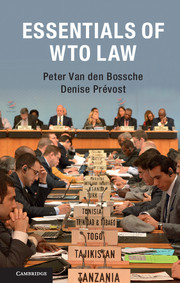Book contents
- Frontmatter
- Contents
- List of figures and tables
- Preface
- List of abbreviations
- Table of cases
- 1 International trade and the law of the WTO
- 2 Rules on non-discrimination
- 3 Rules on market access
- 4 Trade liberalization and other societal values and interests
- 5 Rules on unfair trade
- 6 Rules regarding harmonization of national regulation
- 7 The institutional aspects of the WTO
- 8 The WTO dispute settlement system
- Online resources
- Index
- References
6 - Rules regarding harmonization of national regulation
- Frontmatter
- Contents
- List of figures and tables
- Preface
- List of abbreviations
- Table of cases
- 1 International trade and the law of the WTO
- 2 Rules on non-discrimination
- 3 Rules on market access
- 4 Trade liberalization and other societal values and interests
- 5 Rules on unfair trade
- 6 Rules regarding harmonization of national regulation
- 7 The institutional aspects of the WTO
- 8 The WTO dispute settlement system
- Online resources
- Index
- References
Summary
Introduction
As customs duties and quotas decrease in importance as barriers to trade in goods, regulatory barriers to trade gain steadily in significance. Technical regulations and standards, as well as sanitary and phytosanitary measures, can pose significant obstacles to trade and may be misused to protect domestic products against competition from imported products. The TBT Agreement and the SPS Agreement aim to prevent such misuse and to minimize the trade-restrictive impact of legitimate regulation. Also, the lack of protection of intellectual property (IP) rights negatively affects trade in goods and services. Therefore, the TRIPS Agreement aims to ensure that the relevant regulations of WTO Members provide a minimum level of effective protection of IP rights.
The three WTO agreements mentioned here, the TBT Agreement, the SPS Agreement and the TRIPS Agreement, have an important aspect in common. Their obligations regarding national regulation go beyond the general rules of the GATT 1994 applicable to non-tariff barriers to trade, which address such measures primarily by prohibiting them (as is the case for quantitative restrictions; see Section 3.4) or by requiring their non-discriminatory application (as is the case for internal taxes and regulations; see Sections 2.2 and 2.4). The TBT Agreement, the SPS Agreement, and the TRIPS Agreement go further than this and promote the harmonization of national regulation on the basis of international standards or rules.
The TBT Agreement
WTO Members have many regulatory requirements in place regarding products that are traded in their territories; for instance, on the composition, quality, safety, production process, packaging and labelling of these products. Such requirements are commonly aimed at achieving legitimate public policy objectives, such as the protection of public health, the environment, consumers or public morals. However, because these regulatory requirements often differ from country to country, and products not meeting the specific requirements of the domestic market are banned, they may constitute formidable barriers to trade. They are also vulnerable to misuse for protectionist purposes. The TBT Agreement imposes disciplines on these technical requirements.
Scope of application
The TBT Agreement applies to:
• technical regulations;
• standards; and
• conformity assessment procedures.
- Type
- Chapter
- Information
- Essentials of WTO Law , pp. 178 - 231Publisher: Cambridge University PressPrint publication year: 2016
References
- 1
- Cited by



